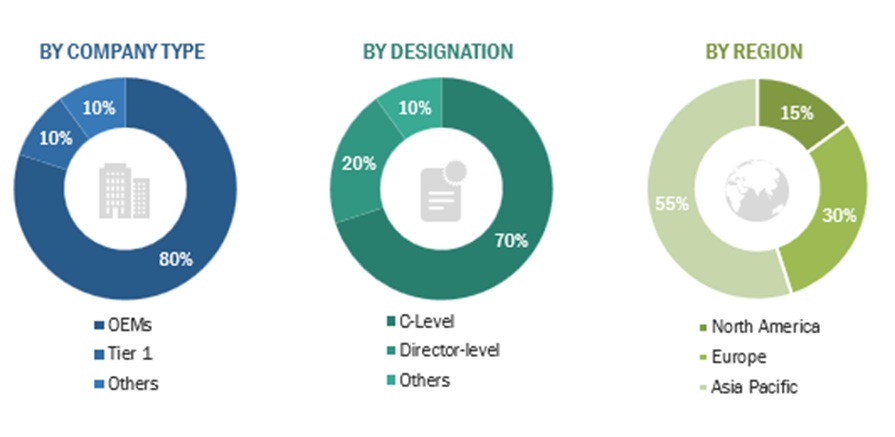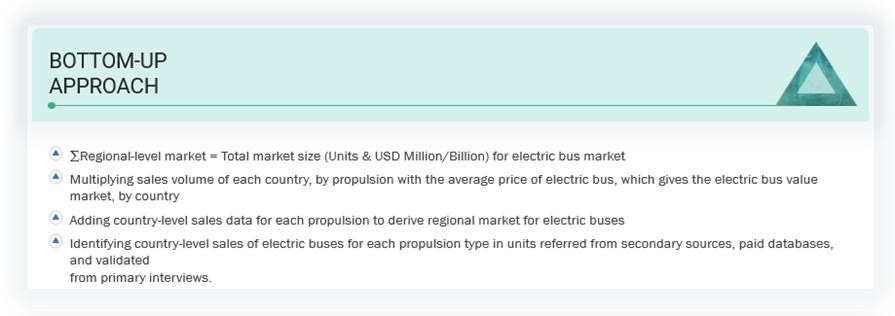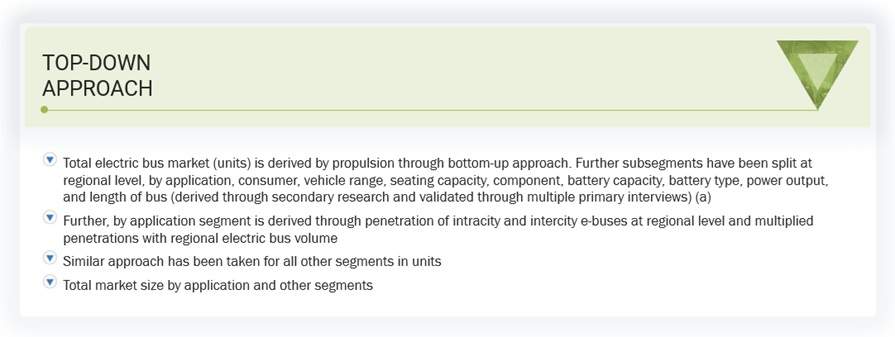The research study involved extensive use of secondary sources such as company annual reports/presentations, industry association publications, automotive powertrain magazine articles, directories, technical handbooks, World Economic Outlook, trade websites, technical articles, and databases to identify and collect information on the Electric Bus Market. Primary sources—experts from related industries, including electric bus OEMs, battery, and other component suppliers —were interviewed to obtain and verify critical information and assess the growth prospects and market estimations.
Secondary Research
Secondary sources for this research study included electric vehicle industry organizations such as the World Electric Vehicle Association and corporate filings such as annual reports, investor presentations, and financial statements. Secondary data was collected and analyzed to determine the total market size, further validated by primary research.
Primary Research
Extensive primary research was conducted through secondary research after understanding the electric bus market scenario. Several primary interviews were conducted with market experts from both the demand (OEMs) and supply (electric bus and component manufacturers) sides across major regions, namely Asia Pacific, Europe, Latin America, the Middle East & Africa, and North America. Approximately 80% and 20% of primary interviews were conducted with the OEM and Tier I/Other players, respectively. Primary data was collected through questionnaires, emails, and telephonic interviews. In the canvassing of primaries, various departments within organizations, such as sales, operations, and marketing, were covered to provide a holistic viewpoint in the report.
After interacting with industry experts, brief sessions were conducted with highly experienced independent consultants to reinforce the findings from primaries. This and the in-house subject matter experts’ opinions led to the findings described in the remainder of this report.

To know about the assumptions considered for the study, download the pdf brochure
Market Size Estimation
BOTTOM-UP APPROACH: ELECTRIC BUS MARKET
The bottom-up approach was used to estimate and validate the size of the electric bus market. The size of the market, by propulsion, in terms of volume and value, was derived by collecting country-level sales of electric buses in units. This gives the volume market for electric buses. Further, the summation of all countries led to the regional-level market in volume.
Bottom-up APPROACH:

To know about the assumptions considered for the study, Request for Free Sample Report
TOP-DOWN APPROACH: ELECTRIC BUS MARKET
The top-down approach was followed for the electric bus market by range, component, length of the bus, battery type, battery capacity, power output, consumer, level of autonomy, seating capacity, and application. For deriving the market size for electric buses by application, in terms of volume, the total volume of the market was multiplied by the penetration percentage of application (city/transit bus, coaches, midibus, and school bus at the regional level). This gives the market by application in terms of volume. A similar approach was used for calculating the market by range, battery type, battery capacity, application, consumer, power output, component, length of bus, and seating capacity.
top-down APPROACH

Data Triangulation
After arriving at the overall size of the vehicles complying with the Electric Bus Market through the methodology mentioned above, the market was split into several segments and subsegments. Data triangulation is a research technique used to increase the validity and reliability of findings by cross-validating data from multiple sources or methods. This technique involves the use of multiple sources of data, such as surveys, interviews, observations, and secondary data, to confirm and corroborate the findings obtained from each source. The extrapolated market data was triangulated by studying various macro indicators and regional trends from both the supply and demand sides.
Market Definition
Fully electric buses are powered by batteries, while hybrid buses utilize a combination of ICE and battery power. These buses are used for the mass transportation of passengers. The batteries can be charged through an off-board top-down pantograph, on-board bottom-up pantograph, and connector. According to Proterra (US), an electric bus is a bus that is powered by one or more electric motors, which are powered by a battery or a hydrogen fuel cell system. According to BYD (China), an electric bus is a bus that is powered by an electric motor and a battery pack, which is charged by plugging it into an electric power source.
Key Stakeholders
-
Associations, Forums, and Alliances Related to Electric Vehicles
-
Automotive Investors
-
Automotive Software Manufacturers and Providers
-
Companies Operating in Autonomous Vehicle Ecosystem
-
Electric Bus Manufacturers
-
Electric Pick-up Truck Manufacturers
-
Electric Truck Manufacturers
-
Electric Van Manufacturers
-
EV Charging Equipment Manufacturers
-
EV Charging Infrastructure Service Providers
-
EV Component Manufacturers
-
EV Component Suppliers
-
EV Distributors and Retailers
-
Government Agencies and Policy Makers
Report Objectives
-
To segment and forecast the electric bus market size in terms of volume & value:
-
By propulsion (BEVs and FCEVs)
-
By length of the bus (less than 9 m, 9–14 m, more than 14 m)
-
By component (batteries, motors, fuel cell stacks, battery management systems, battery cooling systems, DC-DC converters, inverters, AC/DC chargers, and EV connectors)
-
By range (up to 200 miles and above 200 miles)
-
By power output (up to 250 kW and above 250 kW)
-
By battery capacity (up to 400 kWh and above 400 kWh)
-
By application (city/transit bus, coaches, midibus, and school bus)
-
By battery type (LFP batteries, NMC batteries, NCA batteries, and other batteries)
-
By seating capacity (up to 40 seats, 40–70 seats, and above 70 seats)
-
By consumers (government and private)
-
By level of autonomy (semi-autonomous and autonomous)
-
By region (North America, Europe, Asia Pacific, Latin America, and Middle East & Africa)
-
To provide detailed information about the major factors influencing the market growth (drivers, challenges, restraints, and opportunities)
-
To strategically analyze the market concerning individual growth trends, prospects, and contributions to the total market
-
To track and analyze competitive developments, such as product launches, deals, and other activities by key industry participants.
-
To strategically analyze the market with value chain analysis, bill of materials, revenue analysis, and regulatory analysis in the electric bus market
-
To examine the opportunities in the market for stakeholders and provide details of the competitive landscape for market leaders
Available Customizations:
With the given market data, MarketsandMarkets offers customizations according to the specific requirements of companies. The following customization options are available for the report:
Electric Bus Market, by Range at Country-level (For countries covered in the report)
-
Up to 200 miles
-
Above 200 miles
Electric Bus Market, by Battery Type at Country-level (For countries covered in the report)
Company Information
-
Profiles of Additional Market Players (Up to five)



Maria
Jul, 2022
MnM while conducting the given research on “Electric Bus Market” have contacted and conducted primary interviews from all major players from the Electric Vehicle eco-system consisting of Bus manufacturers, bus components manufacturers, EV charging infrastructure service and equipment providers, EV experts, country level government associations and agencies etc. All major market numbers, penetration rates and growth rates have been discussed and validated through primary interviews..